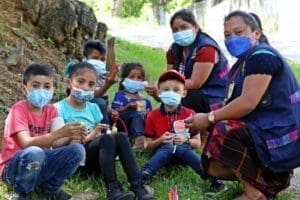Your community, your home, your world: the market at the end of the street, the teachers and students at your school, maybe your mother’s workplace or your father’s trade. You know the kinds of food your grandmother makes, and where your dog likes to run to chase birds and squirrels. You’ve never seen a map of your town because you don’t need one. Other countries are just names, visions on electronic screens, fairytales.

This is often a child’s view of the world before they leave their home, community, and country in search of safety.
But then, their world changes and becomes unsafe, insecure. Desperation sets in. Desperation and determination: to escape violence, including gender-based violence, instability, abuse, or persecution after standing up for your beliefs. Or, determination to grasp an opportunity to fulfill long-held dreams to get an education, reunite with loved ones, or to provide for your family. Migrant children from Guatemala, Honduras, and El Salvador tell us these are the main reasons they flee.
Migration and Return
Migration statistics are overwhelming. Migration policy is opaque. But migrants are people. Migrant children are children first and foremost. Like any child, they are filled with insecurity, uncertainty, and fear at each challenge they encounter as they search for safety.
Every child’s migration journey is unique. Some child migrants reach their destination and are able to remain. Others may be found ineligible for protection and can be deported. In some cases, safe return is in a child’s best interests. Migrant children may fall short of their intended destination and only succeed in reaching a nearby country, where they choose to stay. Whatever the circumstance, some children will ultimately return to their home countries, either voluntarily or through deportation. However, many of the challenges the children fled remain, and often new difficulties arise.
Recognizing these children’s unique needs, Kids in Need of Defense (KIND) launched reintegration programming for unaccompanied children in 2010. The program is rooted in the understanding that a comprehensive response should include both structural changes and long-term assistance to each child, support that can have a radiating impact on families and communities.
KIND’s Child Migrant Return and Reintegration Program (CMRRP) partners with community-based civil society organizations to provide wrap-around support to children and families. This support ideally begins before repatriation and lasts for at least 12 months. Through regular home and community visits and telephone calls, partner organizations provide psychosocial support to address trauma, logistical and financial assistance with enrolling in educational and vocational training programs, and referrals to health, mental health, and legal services as needed. The average age of children we work with is 11 years old. Through a robust case management model, families have proactively engaged in their child’s reintegration process and become agents of change.
Without reintegration support many children will be unable to access or prioritize educational opportunities and may struggle to adjust and manage their mental health, putting them at risk for a host of challenges in their families and communities as they transition to adulthood. Facing a lack of viable alternatives, many of these children will attempt to make the dangerous journey again. KIND’s program is designed to help children and families navigate the complex emotional dynamics of reintegration, to identify the child and family’s strengths and resources, and to develop a plan that supports the child in a positive developmental trajectory and avoids forced remigration. Through this work participants are empowered to tell their stories and identify strategies to move forward.
“One of the biggest changes we have had are the children who have improved their relationships with their families; ties are severed when they migrate, and with reintegration those ties are strengthened, they return to school, resume their lives, and improve their situation.” – KIND Partner
KIND’s reintegration work demonstrates that this programming is both necessary and possible. In addition, it provides a model that governments and international organizations can replicate on varying scales, to better serve migrant children and the communities to which they return.
Until repatriation processes consider the specific needs of children and comprehensive, long-term reintegration services are available to all unaccompanied and separated migrant children returning home, advocacy will continue to be an essential part of KIND’s reintegration model. KIND works together with our reintegration partner organizations in Guatemala and Honduras to develop and share recommendations and best practices for improving return and reintegration processes with civil society and government actors in the United States and Central America and for increasing investment in comprehensive reintegration services for returning migrant children.
Protecting children, recognizing their complex needs, providing space for them to grow and thrive, and accompanying them in their journey to reintegration into their families and communities is vital work at the center of addressing the impact of child migration in Central America. KIND is committed to this effort and to protecting children at every point in their migration journey.
